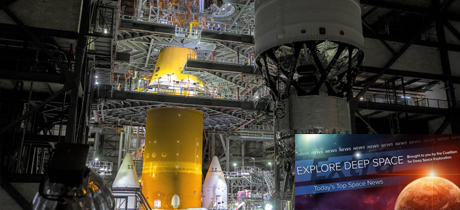In Today’s Deep Space Extra… NASA lays out vision for the long-term future of the Space Launch System rocket. Poland signs the Artemis Accords. Ingenuity has now flown on the Red Planet for a 14th time.
Human Space Exploration
NASA lays out vision for the long-term future of SLS
Space Scout (10/26): NASA has published a request for information (RFI) detailing its plan to transition the Space Launch System (SLS) program from design and development to operational status by the Artemis V mission. According to the RFI, the goal is to ensure SLS remains a “national capability that is a sustainable and affordable system” for at least the next thirty years. NASA aims to move the effective ownership of SLS to a commercial contractor entity, with the agency retaining intellectual property. NASA would become the “anchor tenant” of the new SLS operations system, providing support infrastructure and flying at least one crewed SLS mission yearly for the next decade or more.
Poland signs Artemis Accords
SpaceNews.com (10/27): In a ceremony during the 72nd International Astronautical Congress (IAC), the Polish Space Agency president Grzegorz Wrochna signed the Artemis Accords with NASA Deputy Administrator Pam Melroy. Poland is now the 13th country to join the accords. Wrochna said he saw the Artemis Accords as a first step toward greater cooperation with the United States. He noted that while Poland is a member of the European Space Agency (ESA), Polish space companies are looking to expand their business outside Europe.
Space Science
Release of new decadal survey for astronomy and astrophysics (Natl Acad), November 4, virtual, 2:00-3:00 pm ET
SpacePolicyOnline.com (10/26): The National Academies of Sciences, Engineering, and Medicine will release its latest Decadal Survey for astronomy and astrophysics — Pathways to Discovery in Astronomy and Astrophysics for the 2020s — on November 4, 2021. The public is invited to a webinar from 2:00-3:30 pm ET where the report will be discussed.
Mars helicopter Ingenuity soars through Red Planet’s summer air after radio blackout (video)
Space.com (10/26): Ingenuity, the helicopter that accompanied NASA’s Mars 2020 Perseverance rover to the Red Planet for a landing in February, has now flown for a 14th time. The latest flight for Ingenuity, conducted on Sunday (October 24), was a relatively short and simple “hop,” designed to test its ability to fly with slightly higher rotor speeds, 2,700 revolutions per minute (RPM) rather than the usual 2,537 RPM.
NASA’s Hubble Space Telescope experiences glitch, observations are suspended
Cnet (10/26): The Hubble Space Telescope is facing a new technical challenge. “Hubble’s science instruments went into safe mode on Monday after experiencing synchronization issues with internal spacecraft communications,” The telescope’s account tweeted, adding that the observatory’s instruments remain in good health.
If NASA greenlights this interstellar mission, it could last 100 years
NPR (10/26): NASA’s Voyager 1 and 2 spacecraft flew through the outer solar system and now communicate from beyond with power supplies that are diminishing. A group of experts at the Johns Hopkins University Applied Physics Lab led by John McNutt, a member of the Voyager team, are helping NASA to plan an interstellar successor, a spacecraft that could perhaps travel for a century and study distant dwarf planets as it exits the solar system.
Mysterious radio signal from Proxima Centauri was definitely not aliens
Space.com (10/26): Proxima Centauri is the star closest to the sun – about four light years away. In 2020, Breakthrough Listen began to detect some strange signals from Proxima in its search for sounds that might be linked to extraterrestrial intelligence. The source now seems to be Earthly interference, the project has concluded. The findings were published in the journal Nature Astronomy.
Other News
Lockheed’s acquisition of Aerojet Rocketdyne delayed
Coalition Members in the News – Aerojet Rocketdyne, Lockheed Martin, Northrop Grumman
Breaking Defense (10/26): Lockheed Martin’s proposed $4.4 billion acquisition of Aerojet Rocketdyne is now set to take place during the first quarter of 2022, Lockheed’s chief executive announced. “The Aerojet Rocketdyne transaction continues moving through the regulatory approval process, and we now anticipate closing in the first quarter of 2022,” said Lockheed CEO James Taiclet during an earnings call with investors. “Our strong balance sheet provides us with the capability to close on the Aerojet Rocketdyne transaction, provide robust returns to shareholders and continue to invest in our portfolio to support our customers and drive future growth,” he said.

